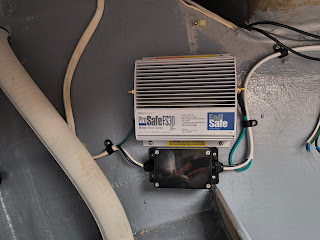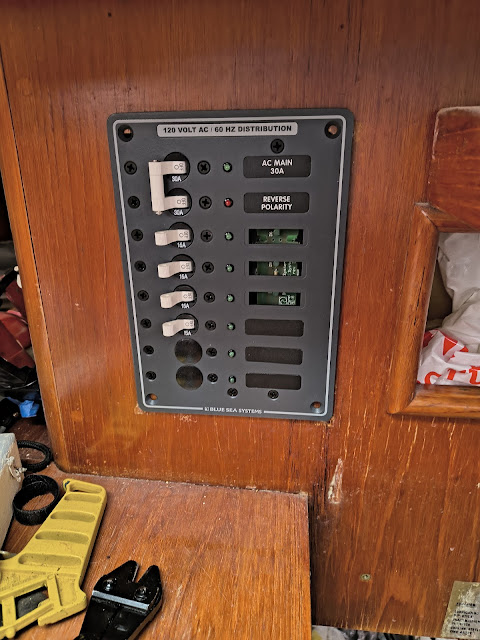I could have saved myself a lot of work by just bolting the old chainplate back in and calling it a day, but I had a few concerns about the strength of the almost 40 year old aluminum chainplate. Unlike the stainless steel that makes up the shrouds and forestay chainplates, the fatigue strength of aluminum tends to decrease steadily with the number of stress cycles, and can fail with no warning signs. Since the backstay is pretty critical to a boat's rig, I figured it was time to get a new chainplate made up.
The first step was to overdrill all the existing chainplate holes (back to unsaturated wood), then fill the holes with structural epoxy and retapp. The original bolts were 3/8" so I overdrilled with a 3/4" bit and found that there was no water ingress beyond that (phew). I taped the backside of the holes and saturated the surrounding wood with unthickened epoxy. Once that kicked, I filled the holes with thickened structural epoxy and used a small trowel to smooth out the side that was not taped.
While all this was happening, I redesigned the chainplate in CAD so the new chainplate would have additional area that would connect further down the knee. Probably overkill given that the first one lasted almost 40 years, but it certainly wouldn't hurt to have additional connection points in the 'meat' of the knee. I went through several iterations and 3d prints of the design to test fit before I sent the final version for machining.I contacted Mike Quill (the rigging foreman for Niagara when the boat was built) Mike Quill Yacht Rigging and as always, he got back to me very quickly and informed me that the original backstay chainplates were made of 6061-T6 with a hard anodized coating. So I went with the same material and sent the design off to the machine shop (Xometry). Three weeks later the shiny new part was in my hands and ready to install (cost was ~$210 shipped).
Once I had the new chainstay, I retapped the 4 holes that the original chainplate used and dry fitted the new chainplate. Then I tapped the additional 5 holes to secure the new chainplate along the lower section of the knee. I sanded everything down and then re-painted with epoxy bilge paint before bolting it all back together. I had to enlist the help of my wife to get a wrench on the backing nuts while I tightened the bolts down with a socket. I'm not sure how happy she was getting stuffed into the lazarette to perform extreme boat yoga, but she didn't complain.With the chainplate secured, I moved up on deck to seal off the opening. I 3d printed a TPU (D95A) sleeve to go around the chainplate opening and then put down strips of butyl tape on top before screwing down the chainplate cover to compress the butyl tape and make a watertight seal. Probably a lot of work and expense, but I won't be worrying about the backstay breaking loose on my watch.
















